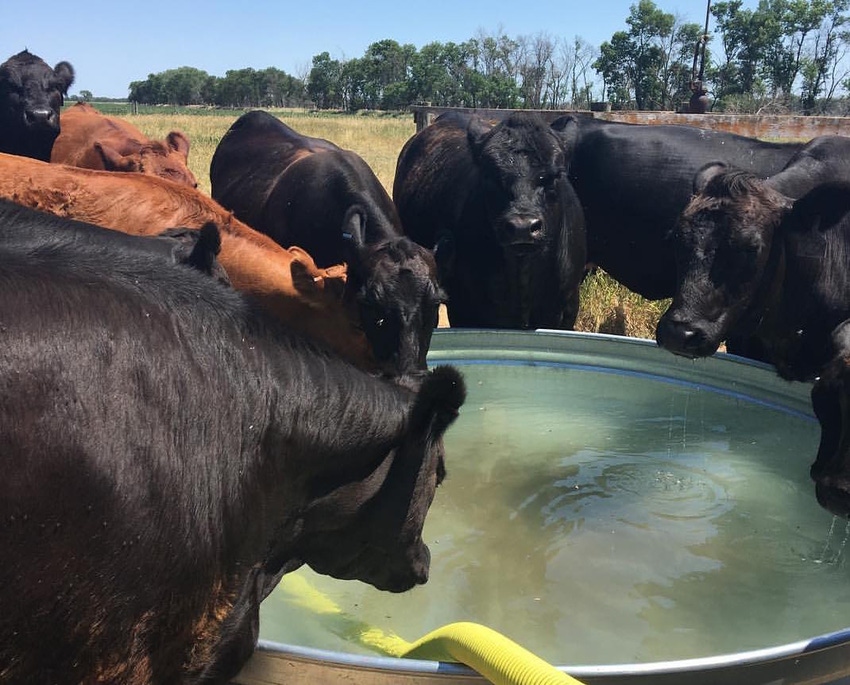Clean water critical for the dog days of summer
It’s time to check for stagnant water and make sure the herd has access to plenty of clean water during these hot summer days.
August 23, 2018

Fall is just around the corner, but before we get to those cool, crisp days, we’ve got to get through the last of the dog days of summer. There are many ways to help cattle beat the heat, but the most critical element is having clean, accessible water for your herd at all times.
Last summer, our ranch was in a drought and we spent our days hauling water to pastures and filling tanks for calves and cows. Fortunately for us, this year has brought ample moisture, so our stock dams are full and the cattle are able to cool off and have plenty to drink during the hot days of summer.
READ: Water, water everywhere? Maybe not.
Robin Salverson, South Dakota State University Extension cow-calf specialist, recently wrote an article about the importance of water for cattle to regulate body temperature, digestion, absorption of nutrients, waste removal, fetal growth and lactation. She offered some tips for providing safe and clean water to cattle on these hot summer days.
Salverson writes, “The amount of water a cow requires varies depending on environmental temperature, lactation status, weight, etc. During the heat of the summer (90°F), data suggest a lactating cow needs 2 gallons of water per 100 pounds of body weight.
Enter the "Genetics In Action" photo contest today for a chance to win a $50 VISA gift card!
“If we use the rule of 2 gallons per 100 pounds of body weight, a spring calving cow (1,300-pound body weight), would require approximately 26 gallons plus another 5 to 10 gallons for the calf.”
She adds, “How many consider the need of the calf? Can the calf reach the tank? How many provide enough access for both cows and calves?
“Providing a tank for calves only is a good management practice. A tank set to the side, filled by the overflow from the cow tank, allows for the calves to drink at the same time as the cows. When we consider non-lactating cows and bulls, they require 1 gallon per 100 pounds of body weight.”
So how much space is needed to give the cattle enough space to drink?
Salverson says, “In larger pastures, a rule of thumb is to have enough water and space to provide enough tank space for 10% of the herd. Allow 12 inches of perimeter for circular tanks and 18 inches for straight side tanks per animal. Contact your local USDA NRCS office to help design a watering system.”
In addition to ensuring cattle have enough water, we must make sure it’s clean, as well. For starters, when hauling water, use a clean tank; never one that has stored chemicals in it.
READ: Need to haul water? Don’t be thrifty; use a clean tank
Also, be sure to watch for blue-green algae growing in stagnant water tanks or stock dams.
“Blue-green algae is toxic to all classes of cattle,” she warns. “Be watchful for colonies of blue-green algae that appear as blueish green scum at or below the water surface.”
Different than other algae, blue-green algae does not appear as a mat, but stays dispersed in the water and moves freely with the wind. “When looked at closely, blue-green algae appears as fine grain of green sand or grass clippings. Not all blue-green algae is blue-green, but can also appear as red.”
READ: Blue-green algae poisoning in domestic animals
Water may be the most under-appreciated nutrient, but as Salverson says, you could have all the grass in the world, but without water, it means nothing. In the hustle and bustle of these final weeks of summer as we prepare for bringing pairs home, weaning and working calves and cows, don’t overlook water, as it’s critical for the health and wellness of your herd.
The opinions of Amanda Radke are not necessarily those of beefmagazine.com or Farm Progress.
About the Author(s)
You May Also Like





